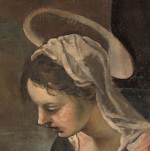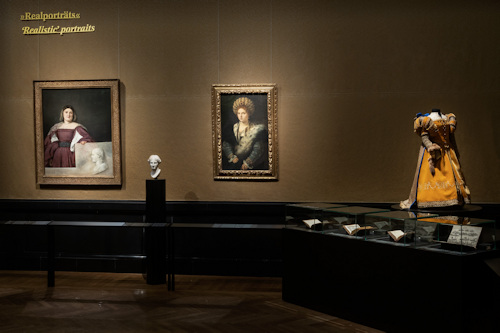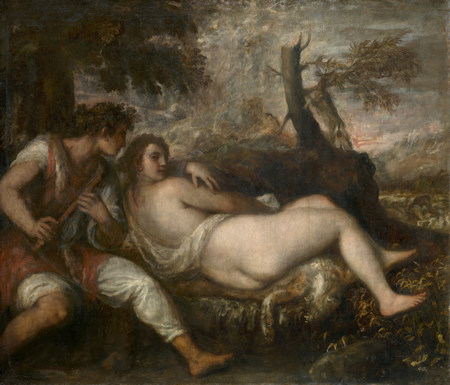The Kunsthistorisches Museum has an early Christmas present for lovers of outstanding art: the year-end Titian exhibition explores the depiction of women by the great Venetian painter and his contemporaries.
- Dozens of paintings by Venetian masters of the 16th century
- Titian dominates but also features works by Tintoretto, Veronese, Bordone and Lotto
- Draws on loans from around the world, as well as the museum’s own prestigious collection
- Runs Oct 5, 2021 – Jan 30, 2022
- See also:
- Kunsthistorisches Museum visitor info
- Selected past KHM exhibitions
- Current art exhibitions in Vienna
Titian’s vision of women
(Exhibition view © KHM-Museumsverband)
Ah, now there’s a name that has left the realms of the specialist art lover to enter the wider public consciousness: Titian (ca.1488-1576). His work echoes down the centuries as a source of inspiration and influence.
In 2021, this pioneer of Italian Renaissance painting forms the core subject of the Kunsthistorisches Museum’s traditional big year-end Old Master exhibition.
These annual exhibitions never disappoint, forming a condensed burst of artistic greatness within just a few galleries. Like an exquisite helping of luxurious whipped cream on the chocolate cake that is the wider art museum.
(Excuse the cake metaphor – this is Vienna, after all.)
Titian’s Vision of Women: Beauty – Love – Poetry follows on from Caravaggio and Bruegel exhibitions in 2019 and 2018. (Let us cast a mantle of silence over 2020, when the Titian exhibition should have opened before fate intervened in the form of COVID-19).
Though our pioneering Italian sits at the forefront of the exhibition, the broader topic is the depiction of women in Titian’s art and in paintings by various contemporaries in the Republic of Venice. These other artists include:
- Jacopo Tintoretto (1518-1594): briefly an apprentice of Titian and a subsequent rival for Venetian patronage and approval, which probably spurred both on to greater heights
- Paolo Veronese (1528-1588): plausibly a protégé of Titian and thus embroiled in that mutual competitiveness between artists of the time. Between them, Titian, Tintoretto and Veronese form the acclaimed trio of 16th-century Venetian painting
- Paris Bordone (1500-1571): possibly another who enjoyed an incomplete apprenticeship with Titian and a troubled relationship thereafter
- Lorenzo Lotto (c.1480–1556/57): another Renaissance great still forced to play second fiddle to Titian’s mastery of the brush
(Titian (1488 – 1567); Nymph and Shepherd; c. 1570/75; © KHM-Museumsverband)
The exhibition features around 60 paintings loaned from other international collections, but also draws on the Kunsthistorisches Museum’s own prestigious archive; the KHM’s collection includes around 30 works by Titian himself, for example (various Habsburgs proved diligent art collectors).
Loan sources include such resonant names as St. Petersburg’s State Hermitage Museum, London’s National Gallery, the Louvre, the Uffizi, and New York’s Metropolitan Museum of Art.
The focus on the portrayal of the female form relates to the peculiar circumstances of the time. In Venice, women enjoyed a heightened status both in sociopolitics and art when compared to other parts of the world.
Equally, Titian might be regarded as the father of the reclining female nude as a motif in painting…the application of the female form to various contexts: allegorical, realistic, historical, idealised, and mythological, for example.
These aspects and associated interpretations colour the exhibition, as well as more technical considerations relating to the depictions themselves and the concomitant fashions and themes on display.
A rather nice touch is the juxtaposition of paintings with items featured within them or associated with them. So, for example, Titian’s 1534/1536 portrait of the Marchioness of Mantua, Isabella d’Este, stands next to a Renaissance dress created as a homage to that same lady by Roberto Capucci in 1994.
Dates and tickets
Admire the Titian and Venetian mastery of colour from October 5th, 2021 to January 30th, 2022. (The original end date was January 16th, but they extended the exhibition by two weeks.)
If you already have, for example, an entrance ticket for the museum, then you need to purchase a timeslot ticket on arrival (or in advance) for the Titian exhibition. Otherwise, you can purchase an exhibition ticket that includes both the timeslot and museum entry.
This timeslot tells you when you can go into the exhibition, but once inside you may stay as long as you want within the museum opening times.
Large exhibitions of this nature normally come with suitable merchandise, too, so look out for that in the Kunsthistorisches museum shops.
How to get to the Titian exhibition
Just follow the tips at the bottom of the main KHM page.
Once there, be sure to wander along into the permanent picture galleries, too.
As I mentioned, the museum has extensive collections that include many of the greatest names in European art history. The Bruegel collection remains a personal favourite.
Address: Burgring 7, 1010 Vienna


